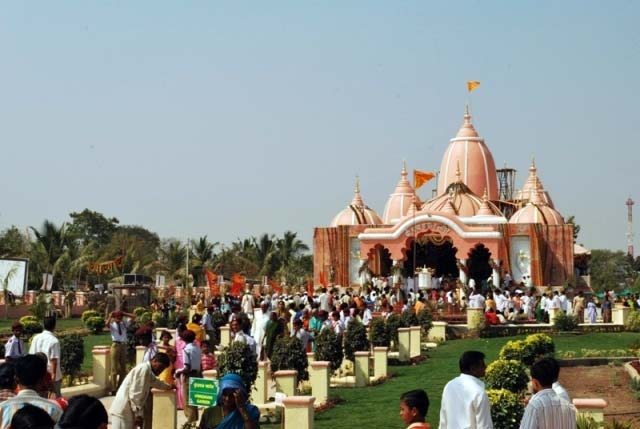50,000 Expected for Aravade Temple Opening Grand Finale
By Anuttama Dasa | Фев 09, 2009

Aravade India—This small village of 5,000 residents, approximately 250 kilometers south of Pune, Maharashtra, is expected to increase its population 10-fold by the end of today, the last of a four day celebration opening the newest ISKCON temple in India.
Pilgrims, curiosity seekers, and members of ISKCON traveled from across India—as well as from Europe, North America, and Africa—to take part in the traditional Vaishnava ceremonies for opening a Krishna temple.
The ceremonies included an opening, night-time Elephant Parade through the local village, inauguration of the new Bhaktivedanta Marg (road) running parallel to the temple, installation of the Garuda Sthapana, (seat of Garuda, Lord Vishnu’s carrier), elaborate Abhisheka (sacred bathing) of the principle Deities, Sri Sri Radha-Gopal, a multi-day Agnihotra (fire ceremony), and a Jhulan Yatra, (swing festival).
The new temple took exactly three years to build. It was designed by a Pune based architect, Mr. Abhinash Khandekar. The cornerstone was laid on the sacred Nityananda Trayodashi day in 2006, and the official grand opening day was the exact same day of this year. The temple, while designed to accommodate just 700 worshipers at any time in its inner sanctum, makes use of extensive gardens and walkways to facilitate many more. Visitors can also circumambulate a three-story replica of sacred Govardhana hill, and neighboring Vrindavana gardens.
For the opening, organizers built a small city of pandals, large decorative Indian tents, to facilitate the thousands of visitors. More than one hundred security guards from a local agency were hired to help direct the crowds between the temple, the main pandal where most ceremonies and evening entertainment occurred, and nearby tents where meals were served.
About 7,000 members of ISKCON attended the event, including thirty direct disciples of Srila Prabhupada. Twelve sanyasis were present, including Governing Body Commissioners Bhakti Caitanya Swami, Gopal Krishna Goswami, and Radhanatha Swami. Most of the ISKCON crowd were housed in pandals, and many hundreds served as volunteers helping with the massive ceremonies, including cooking and organizing for the 50,000 guests expected for the grand-finale on Day Four.















